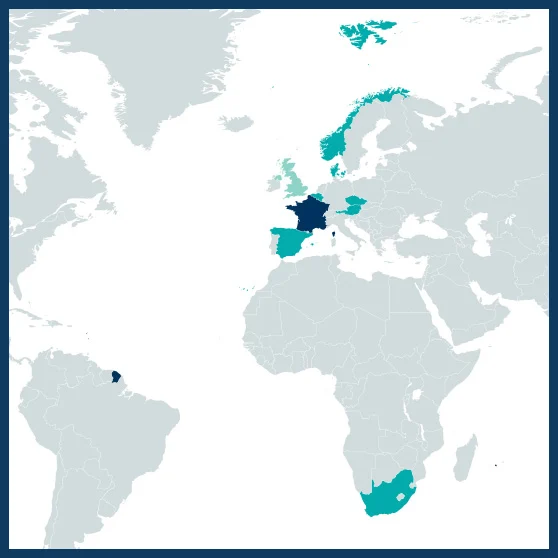01/04/2021 – 31/03/2024
€ 2,108,217
Prof. David Renault
david.renault@univ-rennes1.fr
Metodi SOTIROV
metodi.sotirov@ifp.uni-freiburg.de
Coordinator: Ecosystems, Biodiversity, Evolution (EcoBio) – University of Rennes 1 – Rennes – France
Botany and Biodiversity Research – University of Vienna – Vienna – Austria
Biology – University of Antwerp – Antwerp – Belgium
Invasion Ecology – Academy of Sciences of the Czech Republic – Pruhonice – Czech Republic
Bioscience – Aarhus University – Aarhus – Denmark
Chemistry and Bioscience – Aalborg University – Aalborg – Denmark
National Nature Reserve – Terres Australes Françaises – La Réunion, France
Lille Infection and Immunity Center (CIIL) – University of Lille – Lille – France
Ecology of natural and anthropized hydrosystems (LEHNA) – University Claude Bernard Lyon 1 – Villeurbanne – France
Arctic and Marine Biology – The Arctic University of Norway – Tromso – Norway
Terrestrial Biodiversity – The Norwegian Institute for Nature Research – Trondheim – Norway
Plant and Soil Sciences – University of Pretoria – Pretoria – South Africa
Biology and Geology, Physics and Inorganic Chemistry – University Rey Juan Carlos – Madrid – Spain
University of Birmingham – School of BioSciences College of Life and Environmental Sciences – Birmingham – United Kingdom British Antarctic Survey – Cambridge – United Kingdom

In these times of rapidly accelerating global changes, our planet’s biodiversity is being challenged to adapt. For many species, this means adjusting their life cycle, interactions and distributions as a reaction to the changes occurring in their habitats. These rapid changes, such as changes in habitat characteristics, pollution, biological invasions and climate change are together creating extra pressures on native communities. Polar and alpine regions host most of the world’s last remaining wilderness ecosystems, yet are also particularly vulnerable to these dynamic changes. These ecosystems are disproportionately affected by climate change, and are suffering from a rapidly increasing influx of new species originating from warmer regions of the planet. A growing number of non- indigenous invertebrates, plants and vertebrate species have now colonized these environments, profiting from increased human-related disturbances. They are increasingly outcompeting indigenous species thanks to their life-history strategies adapted to opportunistic change, disturbance and warmer and more variable climates.
ASICS aims to significantly improve understanding of the effects of climate change on the distributions of both non-indigenous and native species in cold environments. To achieve this, a broad array of experimental approaches, notably on species reactions to climate change, cutting-edge modelling techniques, and decade-long time series of species occurrence and climatic data will be used. Ultimately, ASICS aims to achieve accurate and reliable forecasting of future species redistributions that will allow us to anticipate their impact and cost in cold regions. In a world where environmental changes have become virtually unstoppable, being able to anticipate responses and consequences gives valuable knowledge to pre-emptively prevent, mitigate and/or be prepared for the negative effects of biological invasion processes.
Species physiology & adaptation to climate change – ASICS will improve mechanistic understanding of species thermal physiology, thereby providing the key to better predict biodiversity loss and redistribution under different scenarios of future climate change. This will help in the development of future management strategies, policies and budgets, and will thus better equip humanity to tackle emerging threats for biodiversity in polar regions.
Species redistribution – ASICS aims to evaluate the extent and impacts of both climate-related range shifts and biological invasions in polar and alpine regions to improve our understanding of the factors controlling the current distribution of species. This will allow us to inform biodiversity managers of the local and regional habitats primarily at risk from biodiversity changes.
Species interaction & ecosystem functioning – Species interactions – and their dynamics due to climate change – to arrive at generalisable findings of environmental change effects on species redistributions will be taken into account. As such, we can pinpoint the winners and losers of accelerating changes in cold- climate regions. This research will be the ultimate test to assess the stability and/ or vulnerability of cold-region ecosystems towards species redistributions.
Providing tools for management & policy makers – With unprecedented levels of global connectivity through human activities, the movement of species around the world has never been greater. Combined with a warming climate, invasive species are set to threaten biodiversity in even the coldest regions. Environmental risk assessments for key areas will be developed. In order to ensure that our findings are able to inform change or offer advice that will protect and conserve the world’s fragile polar and alpine environments, ASICS will liaise with appropriate committees, managers and policy makers in relevant study regions.